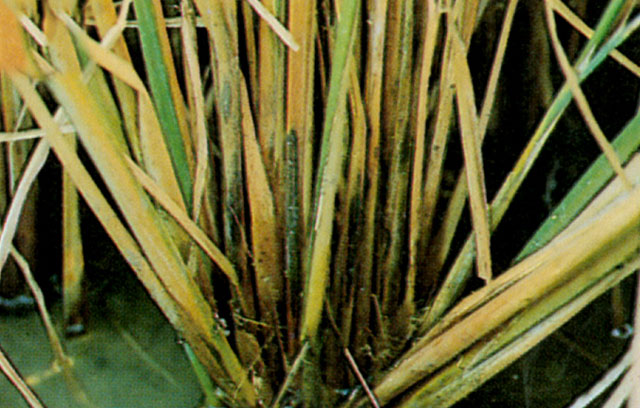Stem rot
What it does
 Stem rot leads to formation of lesions and production of chalky grains and unfilled panicles.
Stem rot leads to formation of lesions and production of chalky grains and unfilled panicles.
Why and where it occurs
The infection bodies or sclerotia are found in the upper soil layer. They survive in air-dry soil, buried moist rice soil, and in tap water. They can also survive on straw, which is buried in the soil. The sclerotia float on irrigation water and infect newly planted rice during land preparation.
Infection is high on plants with wounds as a result of lodging or insect attack. The panicle moisture content and nitrogen fertilizer also influence disease development.
How to identify
Check the plant for the following symptoms:
Infected stem rots
- visible numerous tiny white and black sclerotia and mycelium inside the infected culms
- infected culm lodges and caused unfilled panicles and chalky grain
Initial symptoms are small, irregular black lesions on the outer leaf sheath near water level. Lesions expand as the disease advances.
Severe infection causes tiller death.
Why is it important
The infection is seen on the rice crop during early heading and grain filling. The leaf sheaths decay and cause lodging and lower grain filling. It can cause heavy losses in many countries.
For example, in Japan, there are 51,000−122,000 hectares infected and estimated annual losses of 16,000−35,000 due to this disease. In Vietnam, the Philippines, and India, losses from 30% to 80% were recorded.
How to manage
- Use resistant cultivars.
Contact your local agriculture office for an up-to-date list of available varieties. - Burn straw and stubble or any crop residue after harvest or let the straw decompose.
- Drain the field to reduce sclerotia.
- Balance the use of fertilizer or perform split application with high potash and lime to increase soil pH.
- Chemicals such as fentin hydroxide sprayed at the mid-tillering stage, thiophanate-methyl sprayed at the time of disease initiation can reduce stem rot incidence in the rice field.
- Other fungicides such as Ferimzone and validamycin A also show effectivity against the fungus.
Content experts: Adam Sparks (email: a.sparks@irri.org), NP Castilla, CM Vera Cruz, and FA Elazequi. (Revised as of March 1, 2016)